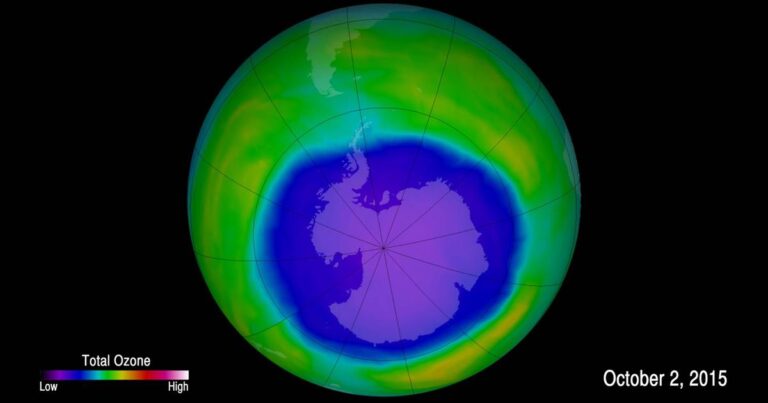
Ozone gas is naturally present in Earth’s atmosphere, mostly in the stratosphere, where it filters out much of the sun’s harmful ultraviolet (UV) radiation before it reaches Earth. Overexposure to this UV radiation can cause skin cancers, cataracts and immune-deficiency disorders in humans, badly affects aquatic life just below the surface of water, the basis of the ocean food chain, and slows down plant growth, reducing agricultural productivity.
In the absence of the ozone layer, life on Earth’s surface would be sterilised. On the other hand, some exposure to UV radiation is necessary to stimulate vitamin D production in human skin.
Ozone is a form of oxygen. Ordinary oxygen molecules are composed of two atoms of oxygen (O2). UV radiation splits some of these molecules into individual atoms of oxygen (O) in the atmosphere, and these O atoms can join with ordinary O2 to form ozone (O3). Ninety per cent of atmospheric ozone is in the lower stratosphere, which is 15km-35km high.
Thinning of the ozone layer was noticed in the 1970s. The seriousness of the situation was emphasised in 1985 when holes were discovered, precipitating international action to deal with the situation. A recent World Meteorological Organisation report describes the remarkable success of these efforts, predicting that the ozone layer will be restored to 1980 values (before holes appeared) by 2066 over Antarctica, by 2045 over the Arctic and by 2042 everywhere else. This sets a precedent for climate action, showing that countries of the world can come together, set target outcomes and achieve them.
It was also discovered in the 1970s that the cause of the thinning of the ozone layer was release of certain man-made chemicals to the atmosphere – mainly hydrochlorofluorocarbons and chlorofluorocarbons. These ozone depleting substances (ODS) were used in a wide range of industrial/consumer applications, mainly refrigerators, air-conditioners, fire extinguishers and propellants in deodorant and hair-lacquer spray cans.
[ Banning of certain chemicals sees recovery of layer which protects against ultraviolet rays ]
Ozone depletion is greatest at the South Pole. Peak depletion usually occurs in early October when the ozone layer there is often completely destroyed, creating the “ozone holes” seen in satellite observations. Although ozone losses are less severe in the northern hemisphere, significant thinning is seen over the Arctic and over continental Europe.
In 1987 the international community established the Montreal Protocol to cut down on the production and consumption of ODS, reducing their presence in the atmosphere and protecting the ozone layer. This was the first international treaty signed by all countries in the world and is the greatest environmental success story in the UN’s history.
Global consumption of ODS has reduced by 98 per cent since countries began to take action under the Montreal Protocol. Nevertheless, the ozone layer won’t fully recover before the second half of this century because ODS, once released, remain in the atmosphere for many years, continuing to cause damage. Because of this lag effect, the ozone hole over Antarctica continued to grow in the years following adoption of the Montreal Protocol. But, the size of this hole has been decreasing since 2000.
Ozone-depleting substances are manufactured by a relative handful of chemical companies while emissions from fossil fuel are extremely widespread, embedded in almost every activity in societies
Most ODS are also greenhouse gases, some 14,000 times stronger than carbon dioxide, the main greenhouse gas. The Montreal Protocol therefore had a positive effect on global warming. Phasing out ODS prevented up to one degree of warming that otherwise would have occurred by 2050. The ODS were substituted by other man-made gases to replace ODS in some applications. These new gases don’t damage the ozone layer but they do have a significant global warming effect. Steps are now in train to reduce or eliminate use of these gases.
The success in healing the ozone layer is very heartening, injecting much-needed optimism into the fight to control global warming. However, global warming is a much tougher nut to crack for several reasons. For example, greenhouse gases such as carbon dioxide stay in the atmosphere much longer than ODS. Also, ODS are manufactured by a relative handful of chemical companies while emissions from fossil fuel are extremely widespread, embedded in almost every activity in societies.
The healing of the ozone layer must be carefully monitored to ensure we have no setbacks. For example, a global geoengineering project has been proposed to reduce global warming. This proposes spraying millions of tonnes of reflective sulphur particles into the atmosphere to deflect incoming sunlight and reduce global temperature. However, this action would also reduce atmospheric ozone by an estimated 10 per cent. Much research is needed before any such global engineering project is sanctioned.
William Reville is an emeritus professor of biochemistry at UCC